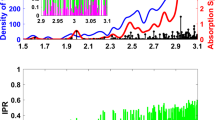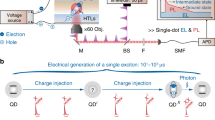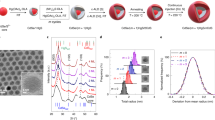Abstract
Applications of semiconductor nanocrystals such as biomarkers and light-emitting optoelectronic devices require that their fluorescence quantum yield be close to 100%. However, such quantum yields have not been obtained yet, in part, because non-radiative Auger recombination in charged nanocrystals could not be suppressed completely. Here, we synthesize colloidal core/thick-shell CdSe/CdS nanocrystals with 100% quantum yield and completely quenched Auger processes at low temperatures, although the nanocrystals are negatively photocharged. Single particle and ensemble spectroscopy in the temperature range 30–300 K shows that the non-radiative Auger recombination is thermally activated around 200 K. Experimental results are well described by a model suggesting a temperature-dependent delocalization of one of the trion electrons from the CdSe core and enhanced Auger recombination at the abrupt CdS outer surface. These results point to a route for the design of core/shell structures with 100% quantum yield at room temperature.
This is a preview of subscription content, access via your institution
Access options
Subscribe to this journal
Receive 12 print issues and online access
$259.00 per year
only $21.58 per issue
Buy this article
- Purchase on Springer Link
- Instant access to full article PDF
Prices may be subject to local taxes which are calculated during checkout



Similar content being viewed by others
References
Murray, C. B., Norris, D. J. & Bawendi, M. G. Synthesis and characterization of nearly monodisperse CdE (E=S, Se, Te) semiconductor nanocrystallites. J. Am. Chem. Soc. 115, 8706–8715 (1993).
Hines, M. A. & Guyot-Sionnest, P. Synthesis and characterization of strongly luminescing ZnS-capped CdSe nanocrystals. J. Phys. Chem. 100, 468–471 (1996).
Nirmal, M. et al. Fluorescence intermittency in single cadmium selenide nanocrystals. Nature 383, 802–804 (1996).
Derougemont, F., Frey, R., Roussignol, P., Ricard, D. & Flytzanis, C. Evidence of strong Auger recombination in semiconductor-doped glasses. Appl. Phys. Lett. 50, 1619–1621 (1987).
Chepic, D. I. et al. Auger ionization of semiconductor quantum drops in a glass matrix. J. Lumin. 47, 113–127 (1990).
Klimov, V. I., Mikhailovsky, A. A., McBranch, D. W., Leatherdale, C. A. & Bawendi, M. G. Quantization of multiparticle Auger rates in semiconductor quantum dots. Science 287, 1011–1013 (2000).
Shen, Y. C. et al. Auger recombination in InGaN measured by photoluminescence. Appl. Phys. Lett. 91, 141101 (2007).
Fuchs, G., Schiedel, C., Hangleiter, A., Harle, V. & Scholz, F. Auger recombination in strained and unstrained InGaAs/InGaAsP multiple quantum wells. Appl. Phys. Lett. 62, 396–398 (1993).
Frantsuzov, P. A. & Marcus, R. A. Explanation of quantum dot blinking without the long-lived trap hypothesis. Phys. Rev. B 72, 155321 (2005).
Galland, C. et al. Two types of luminescence blinking revealed by spectroelectrochemistry of single quantum dots. Nature 479, 203–207 (2011).
Rosen, S., Schwartz, O. & Oron, D. Transient fluorescence of the off state in blinking CdSe/CdS/ZnS semiconductor nanocrystals is not governed by Auger recombination. Phys. Rev. Lett. 104, 157404 (2010).
Cichos, F., von Borczyskowski, C. & Orrit, M. Power-law intermittency of single emitters. Curr. Opin. Colloid Interface Sci. 12, 272–284 (2007).
Frantsuzov, P., Kuno, M., Janko, B. & Marcus, R. A. Universal emission intermittency in quantum dots, nanorods and nanowires. Nature Phys. 4, 519–522 (2008).
Kuno, M., Fromm, D. P., Hamann, H. F., Gallagher, A. & Nesbitt, D. J. Nonexponential ‘blinking’ kinetics of single CdSe quantum dots: a universal power law behavior. J. Chem. Phys. 112, 3117–3120 (2000).
Wang, X. et al. Non-blinking semiconductor nanocrystals. Nature 459, 686–689 (2009).
Mahler, B. et al. Towards non-blinking colloidal quantum dots. Nature Mater. 7, 659–664 (2008).
Chen, Y. et al. ‘Giant’ multishell CdSe nanocrystal quantum dots with suppressed blinking. J. Am. Chem. Soc. 130, 5026–5027 (2008).
Spinicelli, P. et al. Bright and grey states in CdSe–CdS nanocrystals exhibiting strongly reduced blinking. Phys. Rev. Lett. 102, 136801 (2009).
Gomez, D. E., van Embden, J., Mulvaney, P., Fernee, M. J. & Rubinsztein-Dunlop, H. Exciton–trion transitions in single CdSe–CdS core–shell nanocrystals. ACS Nano 3, 2281–2287 (2009).
Raino, G. et al. Probing the wave function delocalization in CdSe/CdS dot-in-rod nanocrystals by time- and temperature-resolved spectroscopy. ACS Nano 5, 4031–4036 (2011).
Brokmann, X., Coolen, L., Dahan, M. & Hermier, J. P. Measurement of the radiative and nonradiative decay rates of single CdSe nanocrystals through a controlled modification of their spontaneous emission. Phys. Rev. Lett. 93, 107403 (2004).
Kim, S., Fisher, B., Eisler, H. J. & Bawendi, M. Type-II quantum dots: CdTe/CdSe(core/shell) and CdSe/ZnTe(core/shell) heterostructures. J. Am. Chem. Soc. 125, 11466–11467 (2003).
Muller, J. et al. Air-induced fluorescence bursts from single semiconductor nanocrystals. Appl. Phys. Lett. 85, 381–383 (2004).
Brovelli, S. et al. Nano-engineered electron–hole exchange interaction controls exciton dynamics in core–shell semiconductor nanocrystals. Nature Commun. 2, 280 (2011).
Donega, C. D., Bode, M. & Meijerink, A. Size- and temperature-dependence of exciton lifetimes in CdSe quantum dots. Phys. Rev. B 74, 085320 (2006).
Nirmal, M. et al. Observation of the dark exciton in CdSe quantum dots. Phys. Rev. Lett. 75, 3728–3731 (1995).
Louyer, Y., Biadala, L., Tamarat, P. & Lounis, B. Spectroscopy of neutral and charged exciton states in single CdSe/ZnS nanocrystals. Appl. Phys. Lett. 96, 203111 (2010).
Galland, C. et al. Lifetime blinking in nonblinking nanocrystal quantum dots. Nature Commun. 3, 908 (2012).
Bartsch, G. et al. Positively versus negatively charged excitons: a high magnetic field study of CdTe/CdMgTe quantum wells. Phys. Rev. B 83, 235317 (2011).
Shabaev, A., Rodina, A. & Efros, A. L. Fine structure of the band edge excitons and trions in CdSe/CdS core/shell nanocrystals. Phys. Rev. B 86, 205311 (2012).
Nethercot, A. H. Prediction of Fermi energies and photoelectric thresholds based on electronegativity concepts. Phys. Rev. Lett. 33, 1088–1091 (1974).
Steiner, D. et al. Determination of band offsets in heterostructured colloidal nanorods using scanning tunneling spectroscopy. Nano Lett. 8, 2954–2958 (2008).
Pandey, A. & Guyot-Sionnest, P. Intraband spectroscopy and band offsets of colloidal II–VI core/shell structures. J. Chem. Phys. 127, 104710 (2007).
Peng, X. G., Schlamp, M. C., Kadavanich, A. V. & Alivisatos, A. P. Epitaxial growth of highly luminescent CdSe/CdS core/shell nanocrystals with photostability and electronic accessibility. J. Am. Chem. Soc. 119, 7019–7029 (1997).
Sitt, A., Della Sala, F., Menagen, G. & Banin, U. Multiexciton engineering in seeded core/shell nanorods: transfer from type-I to quasi-type-II regimes. Nano Lett. 9, 3470–3476 (2009).
Smith, A. M., Mohs, A. M. & Nie, S. Tuning the optical and electronic properties of colloidal nanocrystals by lattice strain. Nature Nanotech. 4, 56–63 (2009).
Mauser, C. et al. Spatio-temporal dynamics of coupled electrons and holes in nanosize CdSe–CdS semiconductor tetrapods. Phys. Rev. B 82, 081306 (2010).
Efros, A. L. Luminescence polarization of CdSe microcrystals. Phys. Rev. B 46, 7448–7458 (1992).
Cragg, G. E. & Efros, A. L. Suppression of Auger processes in confined structures. Nano Lett. 10, 313–317 (2010).
Mahler, B., Lequeux, N. & Dubertret, B. Ligand-controlled polytypism of thick-shell CdSe/CdS nanocrystals. J. Am. Chem. Soc. 132, 953–959 (2010).
Acknowledgements
Al.L.E. acknowledges financial support from the Office of Naval Research and Alexander-von-Humboldt Foundation. A.S. acknowledges support from the Center for Advanced Solar Photophysics (CASP), an Energy Frontier Research Center founded by the Office of Basic Energy Sciences (OBES), Office of Science (OS), US Department of Energy (US DOE). C.J., B.D. and J-P.H. acknowledge support from the Agence Nationale de la Recherche, and the Région Ile-de-France. B.D. acknowledges support from the ESPCI and J-P.H acknowledges support from the Institut Universitaire de France. F.L. and D.R.Y. acknowledge support from the EU Seventh Framework Programme (grant no. 237252, Spin-optronics). The authors thank T. Pons, N. Lequeux, E. Cassette, M. Tessier, I. Maksimovic, N. Bergeal and R. Lobo for stimulating discussions and advice. The authors are also grateful to Xiangzhen Xu for expert help with TEM measurements.
Author information
Authors and Affiliations
Contributions
C.J. and B.M. synthesized the nanocrystals. C.J. and G.C. performed the single particle measurements under the guidance of B.D., S.B., X.Q. and J-P.H. L.B and F.L. performed the measurements in magnetic fields under the guidance of D.Y. and M.B. Al.L.E., A.R. and A.S. developed the theoretical model. C.J., B.D., J-P.H., L.B., D.Y. and Al.L.E. analysed and interpreted the data. C.J., B.D. and Al.L.E. wrote the manuscript with the assistance of all other co-authors.
Corresponding authors
Ethics declarations
Competing interests
The authors declare no competing financial interests.
Supplementary information
Supplementary information
Supplementary information (PDF 2715 kb)
Rights and permissions
About this article
Cite this article
Javaux, C., Mahler, B., Dubertret, B. et al. Thermal activation of non-radiative Auger recombination in charged colloidal nanocrystals. Nature Nanotech 8, 206–212 (2013). https://doi.org/10.1038/nnano.2012.260
Received:
Accepted:
Published:
Issue Date:
DOI: https://doi.org/10.1038/nnano.2012.260
This article is cited by
-
Mid-infrared irradiation keeps nanocrystals bright
Nature Nanotechnology (2021)
-
All-optical fluorescence blinking control in quantum dots with ultrafast mid-infrared pulses
Nature Nanotechnology (2021)
-
Dynamic lattice distortions driven by surface trapping in semiconductor nanocrystals
Nature Communications (2021)
-
Single-particle spectroscopy for functional nanomaterials
Nature (2020)
-
Progress in semiconductor quantum dots-based continuous-wave laser
Science China Materials (2020)



